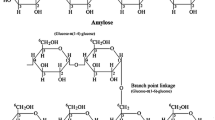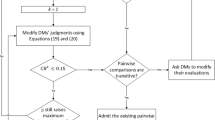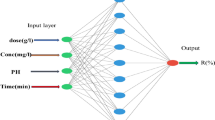Abstract
Considering the influence of reagent adjustment in different flotation bank on the final production index and the difficulty of establishing an effective mathematical model, a coordinated optimization method for dosage reagent based on key characteristics variation tendency and case-based reasoning is proposed. On the basis of the expert reagent regulation method in antimony flotation process, the reagent dosage pre-setting model of the roughing–scavenging bank is constructed based on case-based reasoning. Then, the sensitivity index is used to calculate the key features of reagent dosage. The reagent dosage compensation model is constructed based on the variation tendency of the key features in the roughing and scavenging process. At last, the prediction model is used to finish the classification and discriminant analysis. The simulation results and industrial experiment in antimony flotation process show that the proposed method reduces fluctuation of the tailings indicators and the cost of reagent dosage. It can lay a foundation for optimizing the whole process of flotation.
摘要
在浮选过程中不同工序药剂的调节对最终生产指标均有不同程度的影响, 且难以使用数学模型对此进行有效描述, 为此提出一种基于关键特征变化趋势和案例推理的药剂量协调优化方法。 在分析锑浮选过程中药剂量专家调节方式的基础上, 构建基于案例推理的粗选–扫选工序药剂量预设定模型; 采用敏感性指数计算粗选、 扫选工序对药剂量变化敏感的关键特征, 提出基于关键特征变化趋势的粗选工序药剂量修正规则库; 同时, 利用粗选关键特征变化趋势预测获取扫选工序关键特征变化趋势, 建立扫选工序的药剂修正规则库进行提前补偿; 最后, 采用预估模型进行指标的分类判断, 实现不同工序的药剂修正。 某锑浮选过程工业数据的验证说明所提方法的有效性, 能有效稳定锑浮选的精矿品位和尾矿品位。
Similar content being viewed by others
References
JOVANOVIC I, MILJANOVIC I. Contemporary advanced control techniques for flotation plants with mechanical flotation cells–A review [J]. Minerals Engineering, 2015, 70: 228–249.
MORAR S H, HARRIS M C, BRADSHAW D J. The use of machine vision to predict flotation performance [J]. Minerals Engineering, 2012, 36(10): 31–36.
ZHOU Kai-jun, YANG Chun-hua, GUI Wei-hua. Clustering-driven watershed adaptive segmentation of bubble image [J]. Journal of Central South University of Technology, 2010, 17(5): 1049–1057.
PEREZ-CORREA R, GONAALEZ G, CASALI A. Dynamic modeling and advanced multivariable control of conventional flotation circuits [J]. Minerals Engineering, 1998, 11(4): 333–346.
HODOUIN D, BAZIN C, GAGNON E. Feed forwardfeedback predictive control of a simulated flotation bank [J]. Power Technology, 2000, 108(2): 173–179.
NAIK P K, REDDY P, MISRA V N. Interpretation of interaction effects and optimization of reagent dosages for fine coal flotation [J]. International Journal of Mineral Processing, 2005, 75(1): 83–90.
ZHU Jian-yong, GUI Wei-hua, YANG Chun-hua. Probability density function of bubble size based reagent dosage control for flotation process [J]. Asian Journal of Control, 2014, 16(3): 765–777.
LIU J J, MACGREGOR J F. Froth-based modeling and control of flotation processes [J]. Minerals Engineering, 2008, 21(6): 642–651.
GENG Zeng-xian, CHAI Tian-you. Intelligently optimal index setting for flotation process by CBR [J]. Journal of Northeastern University: Natural Science, 2008, 29(6): 761–764. (in Chinese)
ZHOU Ping, CHAI Tian-you, WANG Hong. Intelligent optimal-setting control for grinding circuits of mineral processing process [J]. IEEE Transactions on Automation Science & Engineering, 2009, 6(4): 730–743.
LI Hai-bo, ZHENG Xiu-ping, CHAI Tian-you. Hybrid intelligent optimal control in flotation processes [J]. Journal of Northeastern University: Natural Science, 2012, 33(1): 1–5. (in Chinese)
CAO Bin-fang, XIE Yong-fang, GUI Wei-hua. Integrated prediction model of bauxite concentrate grade based on distributed machine vision [J]. Minerals Engineering, 2013, 53: 31–38.
KAARITINEN J, HATONEN J, HYOTYNIEMIH, MIETTUNEN J. Machine-vision-based control of zinc flotation—A case study [J]. Control Engineering Practice, 2006, 14: 1455–1466.
GIANNI B, PATRICK P J, JAYSON T J. Application of numerical image analysis to process diagnosis and physical parameter measurement in mineral processes-Part I: Flotation control based on froth textural characteristics [J]. Minerals Engineering, 2006, 19(6–8):734–747.
ZHU Jian-yong, GUI Wei-hua, YANG Chun-hua. Probability density function of bubble size based reagent dosage predictive control for copper roughing flotation [J]. Control Engineering Practice, 2014, 29: 1–12.
ZHAO Hong-wei, XIE Yong-fang, JIANG Zhao-hui, XU De-gang, YANG Chun-hua. An intelligent optimal setting approach based on froth features for level of flotation cells [J]. Acta Automatica Sinica, 2014, 40(6): 1086–1097. (in Chinese)
WANG Ya-lin, CHEN Xiao-fang, ZHOU Xiao-jun, et al. Hybrid intelligence model based on image features for the prediction of flotation concentrate grade [J]. Abstract and Applied Analysis, 2014, Article ID 401380. DOI: http://dx.doi.org/10.1155/2014/401380.
WU Jia, XIE Yong-fang, YANG Chun-hua. An unsupervised reduction method for the selection of flotation froth image characters and its application [J]. Information and Control, 2014, 43(3): 314–317, 333. (in Chinese)
KAARTIINEN J. Image analysis in mineral flotation [D]. Helsinki: Helsinki University of Technology Control Engineering Laboratory, 1999.
CAO Bin-fang, XIE Yong-fang, YANG Chun-hua, GUI Wei-hua, WANG Xiao-li. Integrated modeling for production index of bauxite flotation based on multi-source data [J]. Control Theory & Applications, 2014, 31(9): 1252–1261. (in Chinese)
LI Yong-gang, GUI Wei-hua. Optimal control for zin solution purification based on interacting CSTR models [J]. Journal of Process Control, 2012, 22(10): 1878–1889.
Author information
Authors and Affiliations
Corresponding author
Additional information
Foundation item: Project(61725306) supported by the National Science Foundation for Distinguished Young Scholars of China; Projects(61473318, 61403136, 61703157, 61751312) supported by the National Natural Science Foundation of China; Project(16C0940) supported by Foundation of Hunan Educational Committee, China
Rights and permissions
About this article
Cite this article
Cao, Bf., Xie, Yf., Gui, Wh. et al. Coordinated optimization setting of reagent dosages in roughing-scavenging process of antimony flotation. J. Cent. South Univ. 25, 95–106 (2018). https://doi.org/10.1007/s11771-018-3720-0
Received:
Accepted:
Published:
Issue Date:
DOI: https://doi.org/10.1007/s11771-018-3720-0




